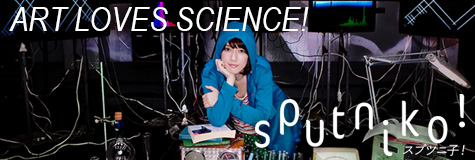
03 Mars and Citizen Science are the Fad at NASA
Sputniko!
Hi again, it's me, Sputniko!
I'm in Houston, Texas, having flown in from Cuba via Mexico City, where I wrote the last post for this series.
The reason I visited Houston was because I was invited to a conference held by NASA.
The Lunar and Planetary Science Conference (LPSC) is a science conference where space scientists gather from all over the world. It started in 1969, the year humans first set foot on the moon, and has now reached its 44th anniversary.
he conference first started because of the Apollo program so "lunar" is in its title, but in fact, they also hold a variety of research presentations about planets, along with social gatherings, every day.
A party called "NASA Night" is where NASA's top people sum up the previous year's results and talk about their goals for the coming year. People from around the world talk heatedly about their love of the universe. I had a wonderful time there.
Mars is currently a hot topic at NASA.
Do you remember the news about the spacecraft landing on Mars in 2012, and the images sent to Earth from NASA's Mars rover Curiosity? Even now, Curiosity is doing research, sending various data from Mars to NASA.
One of the hot topics at the conference is the laser launcher loaded on Curiosity. The device works by firing a laser into Mars's surface, collecting the soil, analyzing the elementary composition, and sending the data to Earth. The system seems to be working excellently, and many researchers were talking about it at NASA Night.
The operator of this laser launcher is a really cute, I-love-science type of woman, and she told me that she's working at NASA because of her love of Mars. A bit (or very) wacky maybe, but she was one cool woman!
Another hot topic at NASA is citizen science, which allows scientists to conduct research with the help of many people. For example, the analysis of the human genome was carried out by connecting people's computers around the world to perform a large-scale computation.
NASA's website shows data on the moon and Mars for free. A project is in progress to get assistance from amateur astronomy fans, which has, in fact, produced many results.
In 2010, five Australian high school girls discovered a new dark nebula, making worldwide news, and this can be said to be another product of citizen science.
Here's an idea for people in the field of anime and manga. Why doesn't someone make a heartwarming anime featuring a high school astronomical club called "Tenmon!" (the Japanese word for astronomy)?
The fact is that the growth of social media is greatly influencing NASA's space research. One day soon, I'd like to create an artwork based on citizen science as well.
* Original text in Japanese, translated to English by the Japan Foundation
Back Issues
- 2022.7.27 Beyond Disasters - T…
- 2022.6.20 Beyond Disasters - T…
- 2021.6. 7 Contributed Article …
- 2021.4.28 Crossing Borders, En…
- 2021.4.27 Contributed Article …
- 2021.4.20 Contributed Article …
- 2021.3.29 Contributed Article …
- 2020.12.22 Interview with the R…
- 2020.12.21 Interview with the R…
- 2020.11.13 Interview with the R…

